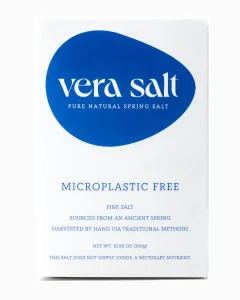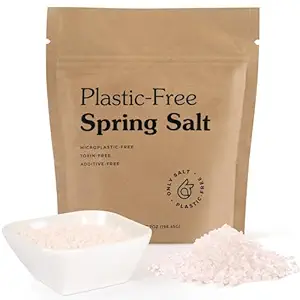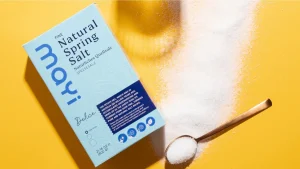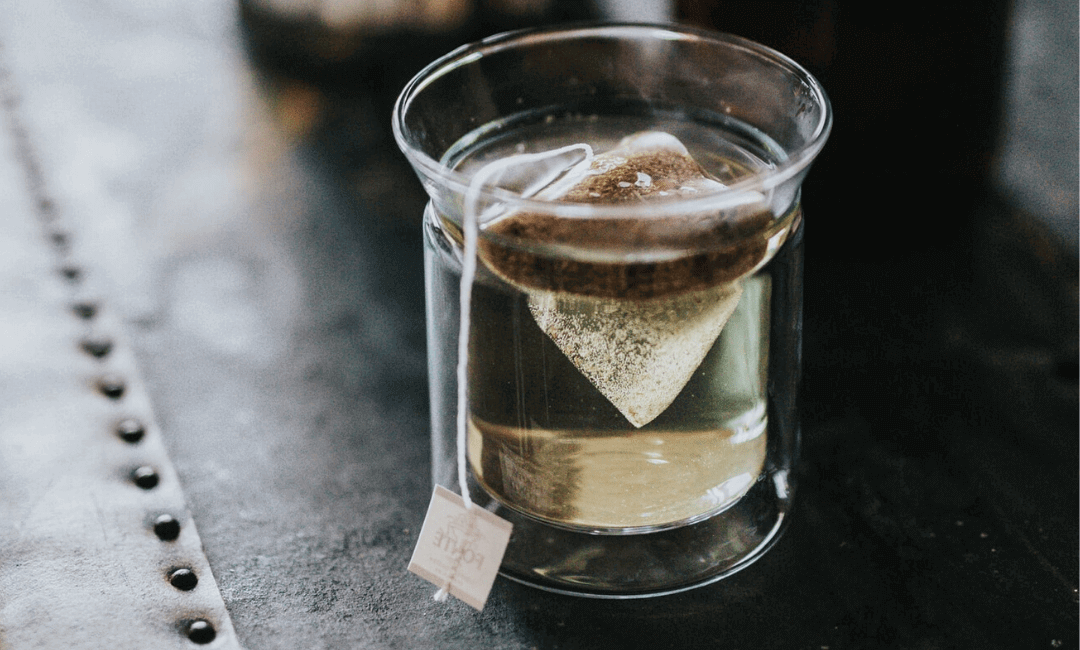The Hidden Ingredient in Salt: 3 Microplastic Free Salt Brands You Can Trust

Salt is a staple in nearly every kitchen around the globe, seasoning our food and enhancing flavors.
But have you ever stopped to think about what else might be in your table salt?
Since it comes mostly from our oceans and by now we should be all aware about plastic pollution, you can imagine what to expect in salt: microplastics.
In fact, different studies (1) confirm that sea salt around the world is contaminated by microplastic particles. In fact, a 2018 study (2), published in the Journal of Environmental Science & Technology concluded that that sea salt can be a good indicator of the magnitude of microplastic pollution in the surrounding marine environment.
A 2019 study (3) published in the Journal: Scientific Reports reviewed microplastic contamination in table salts and found that 94% of globally tested salt products contained microplastics. The most prevalent types were polyethylene terephthalate (PET), polypropylene (PP), and polyethylene (PE), all of which are some of the most commonly used plastic polymers. These tiny plastic particles, often invisible to the naked eye, are finding their way into our salt and, consequently, into our bodies.
What Are Microplastics?
Microplastics are small fragments of plastic, typically less than 5 millimeters in size. There are two types:
- Primary microplastics: they are manufactured as tiny particles for products like microbeads in cosmetics.
- Secondary microplastics: they result from the breakdown of larger plastic items.
They are pervasive in the environment, polluting oceans, rivers, and even the air we breathe. Because salt is often harvested from marine and coastal regions, it’s particularly susceptible to microplastic contamination.
Why Should We Care About Microplastics in Food?
While the long-term effects of ingesting microplastics are still being studied, early findings suggest potential health risks. Microplastics in food can carry harmful chemicals and toxins, and their accumulation in the body may contribute to inflammation and other health concerns. Avoiding microplastics in your diet and try to buy groceries plastic free as much as you can is a proactive step toward better health.
Related: How to Avoid Microplastic in Food. 10 Practical Tips for a Healthy Diet
3 Best Plastic Free Salt Brands to Help You Reduce Your Microplastic Exposure Risks
Here is a selection of salt brands that are free of microplastics.
This post contains affiliate links, which means we may receive a small commission, at no cost to you, if you make a purchase through a link. This helps us continue the hard work we put into researching products and solutions to plastic/ microplastic pollution.
Please Note: Our health content is for informational purposes only and is not intended as professional medical advice. Consult a medical professional on questions about your health. Please read our disclaimer.
1. Vera Salt Pure Natural Spring Salt Microplastic Free
Vera Salt is sourced from an ancient spring on the foothills of Spain at over 2000 feet above sea level. The pristine location is far from human activity and pollution and hosts an underground aquifer that feeds a brine spring, rich in natural minerals like calcium, potassium, and magnesium. The salt is harvested by hand via traditional methods.
Within the values of fighting plastic waste pollution, this company made an effort to offer also 100% plastic free packaging with cardboard on the outside of the product and a biodegradable, compostable inner bag made of potato-starch.
Lab Testing: The salt is third-party lab-tested for microplastics, heavy metals, and other additives. You can find the results on their website.
Visit the Vera Salt website. – Use code IMPLASTICFREE for a 10% discount at check out.
Related: Plastic Free Tea Bags: Which Brands Are Really Plastic Free?
2. Only Plastic-Free Spring Salt
Unrefined and free from harmful additives, this spring salt flows from a natural aquifer 10,000 feet high in the Andes mountains that is untouched by plastic pollutants. This salt has no preservatives, uses no anti-caking agents, no aluminum, and no bleaching. It is just pure flavor in every pinch!
Lab Testing: The company performed an optical analysis of the salt with a 3rd party lab to test for microplastics and shared the test with us. (Please contact the brand if you’d like a copy).
Check the latest price on Amazon USA
Related: Plastic Free Chewing Gum. Do They Exist?
3. Mayi Delice Fine Natural Spring Salt
The source of the Mayi Delice Natural Spring Salt is safely protected underground, free from heavy metals and microplastics. Due to this geo-strategic location of 600 m above sea level and far from any industrial establishments, this table salt still preserves its purity, which emerged 200 million years ago through the Thesis Sea. It is naturally enriched with 82 essential minerals from the richest soils of Anatolia, and it is low in sodium. It’s organic, unrefined, and rich in potassium, magnesium, and calcium, perfect for baking, gourmet meals, and as a natural salt substitute.
Lab Testing: The company shared their microplastic analysis report with us (Please contact the brand if you’d like a copy), as well as a scientific study (4) published in the Journal of Food Science and Technology about a microplastic analysis conducted on their product.
Check the latest price on Amazon USA
Related: Microplastic in Food: The Latest Research
Tips When Choosing Microplastic-Free Salt
1. Source Matters:
Look for brands that harvest salt from cleaner, less polluted environments. Himalayan pink salt and some deep-mined salts are often lower in microplastic contamination due to their terrestrial origins.
2. Certified Testing:
Some companies now test their salt for microplastic contamination and provide certification. Look for “microplastic-free” labels or check the company’s transparency on their sourcing and testing processes.
3. Support Innovation:
Brands and researchers are working on advanced filtration and purification methods to ensure cleaner salt. By supporting these initiatives, you’re contributing to a cleaner food chain.
Related: Is Microplastics Leaching into Your Coffee?
FAQS
How Much Microplastics do we Consume from Salt?
The 2018 study (2) published in the journal Environmental Science & Technology, we mentioned in this article, estimated that as an average an adult ingests approximately 2,000 microplastics per year through salt, mostly due to the high presence of microplastics in the world’s oceans and waterways.
Does Himalayan Salt Have Microplastics?
A study (5) published in the Journal of Environmental Science & Pollution in July 2022, analyzed 7 common Australian commercial salts (table salt, black salt, sea salt, iodised salt, rock salt, fine Himalayan pink salt, and coarse Himalayan pink salt) found in supermarkets. Surprisingly, microplastic contamination was found to be higher in terrestrial salts, such as black salt and Himalayan pink salt, compared to marine salts, with the highest content coming from Himalayan salt. The study suggests that the contamination in mined salts might have originated from manufacturing, packaging, atmosphere, or storage processes. Notably, studies with larger sample sizes are needed, to provide more robust results.
How to Advocate for a Microplastic-Free Future
The presence of microplastics in salt is part of a broader environmental issue tied to plastic pollution. Reducing your plastic consumption and supporting organizations working to tackle this crisis can help mitigate the problem. This is why we founded I’m Plastic Free.
Simple steps into plastic free living, like using reusable bags, avoiding single-use plastics, and supporting bans on microplastics in products can make a significant difference.
Final Thoughts
Salt is an essential ingredient in our lives, but it shouldn’t come with hidden contaminants. By choosing microplastic-free salt and advocating for a cleaner environment, you can protect your health and the planet. Next time you reach for the salt shaker, think about what’s inside – and make the cleaner, healthier choice!
Want to learn more about reducing plastic pollution? Explore innovative solutions with I’m Plastic Free. Together, we can make a difference!
References and Scientific Literature Sources:
(1) https://pubmed.ncbi.nlm.nih.gov/36279784/
(2) https://pubs.acs.org/doi/10.1021/acs.est.8b04180
(3) https://www.nature.com/articles/s41598-019-46417-z
(4) https://link.springer.com/article/10.1007/s13197-024-05942-0
(5) https://pmc.ncbi.nlm.nih.gov/articles/PMC9813175/
Comments
Angela
February 24, 2025 at 8:20 amHere’s another salt to potentially add to the list. Gathering Place Trading Ltd. sells their “Antarctic Pure Sea Salt”, which is labeled as microplastic-free.






Jon Michalek
January 7, 2025 at 9:38 amOnly Vera provided 3rd party lab test results. Salt produced from water source is usually very contaminated and without in-process quality testing the claims of the companies in this report and elsewhere are bogus.
I'm Plastic Free
January 12, 2025 at 7:37 pmHi Jon,
Thanks for your comment. We’ve asked the product manufacturers about their testing and we’ll update the article if they respond.
Kind regards,
Simona
David
March 10, 2025 at 7:16 amI agree with Jon and it has been 2 months. Where are lab test results?
Thanks,
David
I'm Plastic Free
March 10, 2025 at 2:59 pmHi David,
We have updated the article as all 3 brands we featured have provided their third party lab results. If you can’t find the public link, please contact those brands directly and ask to receive the test.
Kind regards,
Simona